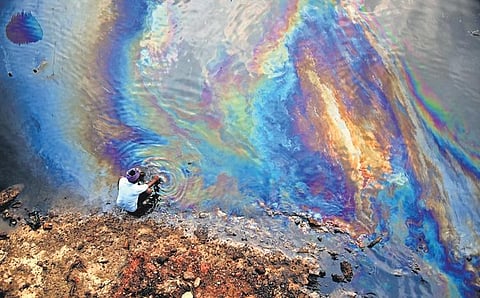

CHENNAI: Since the past few weeks, North Chennai, especially Ennore, has been witnessing thick black oil entering homes along with flood waters from the recent cyclone. The oil spill also polluted the Ennore Creek, Buckingham Canal and the Kosasthaliyar river, crippling the livelihood of thousands of fishermen in the vicinity.
Who is to be blamed for this unprecedented crisis? On December 11, Chief Secretary Shiv Das Meena chaired a High-Level Committee meeting of the State Oil Spill Crisis Management Group, which was constituted in May this year.
A technical committee, after conducting extensive field visits, concluded that the oil spillage had happened from the premises of the Chennai Petroleum Corporation Limited (CPCL). The committee said oil entered the Buckingham canal from the guard ponds and storm water drains of the CPCL before reaching the Ennore Creek.
The technical committee’s report, however, was not made public. It was also not part of the government’s filing before the southern bench of National Green Tribunal, which instituted a suo motu case. The CPCL says is not solely responsible for the oil spill. It blamed the Water Resources Department (WRD) for discharging 48,000 cusecs of water from Poondi and Puzhal reservoirs without giving enough advance notice, causing flooding in all the industries in Manali.
In a written communication to SIPCOT, the Manali Industrial Association had requested the removal of all unauthorised habitations in and around industries spread over water bodies, canals or riverbanks and desilting of all stormwater systems in the industrial area. “We request government to classify Manali industrial area as ‘industrial zone of hazardous chemicals’ and clear all unauthorised habitations in and around the area immediately to mitigate the risks to chemical industry and to the public,” the letter read.
Flood mitigation works?
In 2021, the Centre for Water Resources and the Disaster Management wing of WRD, in response to the CPCL’s concern of the LPG bulk loading facility flooding due to overflow of the Kosasthaliyar river, suggested building a 900 m long 50m x 3.5m canal connecting the river and the water way across the LPG bulk loading causeway.
But, WRD officials said the proposal wouldn’t be executed as the area was now blocked by CPCL land. Environmental activist Nityanand Jayaraman told TNIE no amount of flood mitigation projects will work. “You can’t flood-proof a city, which doesn’t acknowledge the limits to its growth. The city is well past its break point. Storm water drains are micro drains that connect to macro drains like canals that join mega drains like Cooum, Adyar and Kosasthaliyar rivers, which empty the flood water into the sea.
The capacity of mega drains is limited and fixed. Their flood discharge capacity and ability to hold water has been compromised by industrialisation and urbanisation. The sea level rise, which the government is not ready to consider while appraising proposals, only aggravates the situation.
So, the increasing built-up area increases the road run-off and heightens the flood risk,” Jayaraman said. Since the 2015 floods, we only increased the risk by encroaching these rivers like in the case of Kosasthalaiyar in Ennore. “Even as we speak, there are multiple mega industrial projects proposed or at advanced stages of implementation in Ennore and Kosasthaliyar catchment areas,” he said.
Domino effect
While the state government and the CPCL claimed before the NGT that the emergency oil recovery works were over and the cleanup in the mangrove areas will continue under expert guidance, fishermen and activists argue that only superficial work was done and that the crisis is far from over. K Saravanan, a fisherman turned coastal protection activist, and Durga Moorthy from the Chennai Climate Action Group, who travelled to Ennore on Friday, said there was still a lot to be done.
“The oil slick is there in at least 6-7 locations and clean-up personnel were seen on the ground.” The biggest worry due to the oil spill is the loss of livelihood to the fishermen. Sources said the fishermen will not be able to fish in Ennore creek for at least another month. Also, the hydrocarbons from the oil spillage would have already entered the food chain. M V Ramana Murthy, Director, National Centre for Coastal Research (NCCR), said the preliminary analysis reveals the presence of crude oil and waste oil among others. The sediment in the Ennore creek is also contaminated.
“We are taking water and sediment samples every alternate day. Analysis is going on, on how badly the sediment is contaminated and how quickly the ecosystem will recover. This study will help prepare a contingency plan to deal with any such emergencies in the future,” Murthy said. Experts said the bio-accumulation of hydrocarbons must have happened in fish by now.
More studies need to be conducted on both juvenile and adult fishes to know how safe the fish caught in Ennore Creek would be for human consumption. Due to the oil spill, 787 fishing boats that were berthed in nine fishing villages have been affected. The bird population, too, has been hit. This newspaper has already published reports on the impact of the oil spill on fisheries and birds.
Around 50-60 birds, especially Spot-Billed Pelicans, were found painted black with oil. Many of the birds are sick and exhausted. Rescue teams are on the ground to catch a few of the sick birds for rehabilitation. On Friday, a Pelican was caught; efforts are on to rescue a few more. Teams are also augmenting the affected areas with fresh fish feed to reduce stress on the birds.
While TN govt and CPCL cross swords accusing each other for the disaster, the abuse of the Ennore region in terms of unscientific mushrooming of industries and human settlements is at the core of the problem